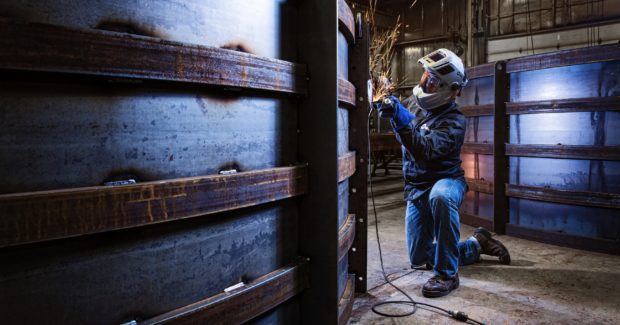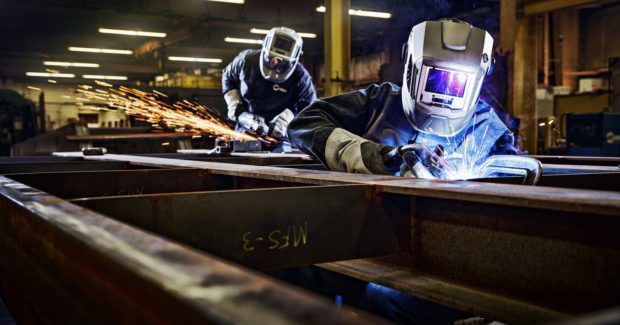The Critical Role of Next Generation Welding Helmets
More comfort. Improved safety. Higher productivity. Better weld quality. Reduced costs. Increased bottom line. This is only the beginning of the reasons why metal fabricators should stay updated on new helmet technologies. There’s more.
Posted: February 17, 2017
Helmets play a critical role in a successful welding operation, impacting welding operator safety, operator comfort, overall productivity and weld quality. There are many reasons why metal fabricators should stay updated on new helmet technologies and invest in these technologies for the benefit of their employees. Advanced helmet technologies help ensure that shops continue to meet safety regulations and compliance requirements, such as those set by the Occupational Safety and Health Administration (OSHA). Ensuring compliance helps companies avoid potential fines that could impact their bottom line. There is also a concern of the rising cost of workplace injuries and related downtime, which can be addressed in part by ensuring that employees are protected with the best possible helmet.
The right helmet can also positively affect welding operator productivity, since a more comfortable welding operator is typically more productive. Today’s welding helmet technologies continue to evolve to meet these varying concerns, which is why it is so important for fabrication shops to consider the benefits of these newer technologies when making a welding helmet selection.
WHY IS THE PROPER HELMET SO IMPORTANT?
Eye injuries are one of the most common injuries in welding environments, and there is an increased push in the industry to help prevent them. Musculoskeletal injuries in the neck and back muscles can also become an issue long term, especially if a welding operator wears a poorly designed helmet (some respiratory helmets can weigh up to three pounds) or if they have poor welding posture. A properly designed helmet offers greater protection against such issues. A helmet that has a good viewing area and a lens with auto-darkening technology reduces eye strain when looking at the weld joint. It also minimizes the need for “nodding” that is associated with putting traditional welding helmets in place by using a forward-neck motion.
Improving the comfort factor also impacts productivity. A helmet that is lighter and cooler can reduce neck strain and fatigue over the course of the work day. Injuries can lead to operator downtime or, potentially, the need for an employee to take time off work. This can negatively impact throughput in the operation. Employee acceptance of safety gear also tends to be better with helmets that are less cumbersome and more comfortable. If the helmet is uncomfortable, welding operators will likely remove it more often, which exposes them to greater risk of hazards and slows down production.
VARIETY OF HELMET OPTIONS AND TECHNOLOGIES
It’s important to choose a helmet that provides the welding operator with the necessary protection against the identified hazards in the workplace, while also allowing him or her to comfortably weld without restraint. Welding helmet manufacturers continue to respond to this need. Next generation helmets available in the marketplace offer numerous distinct advantages, including:
- Reduced helmet weight and improved balance that helps to minimize torque on the welding operator’s neck and lessen fatigue.
- A larger viewing area and better peripheral vision that allow for a clearer view of the weld pool, weld joint and overall work area without causing discomfort.
- Improved clarity, thanks to advancements in lens filter technology that enhance the contrast of the workpiece and provide a more natural tinted welding arc – features that help prevent costly mistakes and rework by making it easier to see the weld pool.
- Headgear technology that uses flexible materials to provide a more secure fit, conforming to each operator’s unique head shape and size. This minimizes irritation of pressure points that could lead to headaches, but will still allow the headgear to survive extended use in harsh welding environments.
Some additional factors to consider when selecting helmets include:
- Next generation helmets are designed with the thinnest and lightest materials available that don’t compromise durability. Slim designs featured in newer helmets also allow entry into tight spaces for welding, making it safer and easier to get the job done.
- Some next generation welding helmets are specifically designed to be used in conjunction with low profile half-mask respirators, providing a comfortable solution that protects the welding operator from weld fumes.
- The shell color can also impact comfort and cooling. Lighter colors, such as silver, are better than black since they don’t absorb as much heat.
RESPIRATORY AND NON-RESPIRATORY HELMET OPTIONS
Increased awareness of weld fume issues continues to support the value of implementing the proper respiratory protection – such as powered air purifying respirators (PAPRs) – in conjunction with a properly-designed helmet. Helmet assemblies come in various options, including PAPR and non-PAPR options, to best meet application needs. Supplied air respirators (SAR) are another option that provide clean, breathable air and relief from heat stress through cool air. With the increasing stringency of the industry’s weld fume regulations, along with a more vested interest by companies in safety, companies may find the need for varying levels of respiratory protection (e.g. half-mask, PAPR or SAR systems). Few manufacturers provide the modularity and variety in their helmet offering to encompass all of these solutions. Look for products that provide the ability to easily select and switch between respiratory solutions that are most comfortable for welding operators and best fit their needs.
Recent technology advancements are designed to drive productivity, safety and comfort in respiratory helmet options. These include airflow improvements: specifically, designs that offer airflow distribution over the front of the welding operator’s face, side of his or her head, and down the neck. By targeting airflow at these areas where blood vessels are located, the cooling effect is maximized as the airflow works to enhance the human body’s natural thermoregulation process. The ability to customize where the air blows on their face helps keep welding operators more comfortable and productive. Welding operator comfort and productivity can also be impacted via the improved head seal designs that are available in today’s respiratory helmets. In these helmets, the head seal is the fabric that drapes around the welding operator’s neck to keep weld fumes out. Newer helmet designs enhance comfort by using softer material for sensitive areas surrounding the neck and face.
Newer respiratory helmet designs also make it easier to get the helmet on and off, thereby reducing downtime. Newer generations of respiratory helmets are also designed to distribute weight so that the respiratory components act as a counterbalance to the front-heavy welding lens, which minimizes strain on the welding operator’s neck.
SOLUTIONS TO IMPROVE COMFORT AND PRODUCTIVITY
Operator safety is absolutely critical in every welding operation. Greater operator comfort can also result in a less fatigued employee and a more productive one that helps provide a positive impact to the shop’s bottom line. Metal fabricators and welding operators should consider recent helmet enhancements with flexible fit and designs when making a selection.






